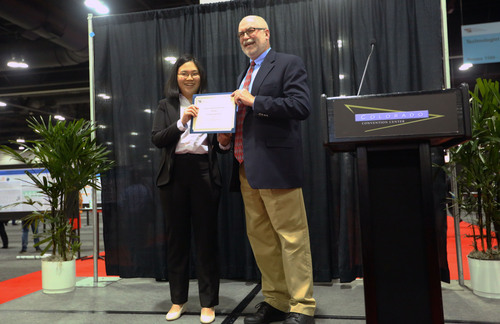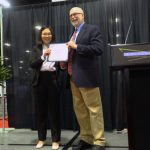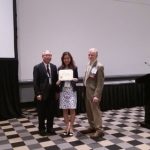 Li Tiantian (left) receives the third prize of the Young Investigator Award from Prof James Galt (right), chairman of the SNMMI CalC Council and a professor at Emory University.
Li Tiantian (left) receives the third prize of the Young Investigator Award from Prof James Galt (right), chairman of the SNMMI CalC Council and a professor at Emory University.
After receiving the first prize at the Asian Nuclear Medicine Academic Forum earlier, the Biomedical Imaging Laboratory (BIG) from the University of Macau’s (UM) Faculty of Science and Technology (FST) and Faculty of Health Sciences (FHS) shined again on world stage. The team received the third prize of the Computer and Instrumentation Council (CalC) Young Investigator Award (YIA) and the International Best Abstract Award at the 64th Annual Meeting of the Society of Nuclear Medicine and Molecular Imaging held in Denver, United States, for their works titled ‘BIGDOSE: Software for 3D Personalised Targeted Radionuclide Therapy Dosimetry’, and ‘High-Performance Virtual CT for Enhanced Targeted Radionuclide Therapy Dosimetry’, respectively. This is the first time a research team from the Greater China region has been shortlisted for, and received an award in this YIA category.
The two related projects were led by Greta Mok, an associate professor from the FST and a joint associate professor from the FHS. Her postgraduate student, Li Tiantian, presented the work at the YIA Symposium, competing with teams from leading institutions such as Stanford University, the University of Illinois at Urbana-Champaign, the University of Texas MD Anderson Cancer Center, and United Imaging Healthcare America. The International Best Abstract Award is given to the paper with the highest score in each region. Based on these two projects, the UM team developed one-stop computing software to provide accurate and precise dosimetric calculation for targeted radionuclide therapy. This tool enhances the efficacy of tumour treatment while reducing unnecessary radiation and toxicity to normal organs, providing a personalised treatment plan for patients based on their own imaging data.
Held in North America, the annual meeting of the Society of Nuclear Medicine and Molecular Imaging is the most influential international conference in nuclear medicine and molecular imaging. This year’s meeting attracted over 5,000 scholars and doctors, as well as over 2,000 scientific abstract submissions.
View gallery


